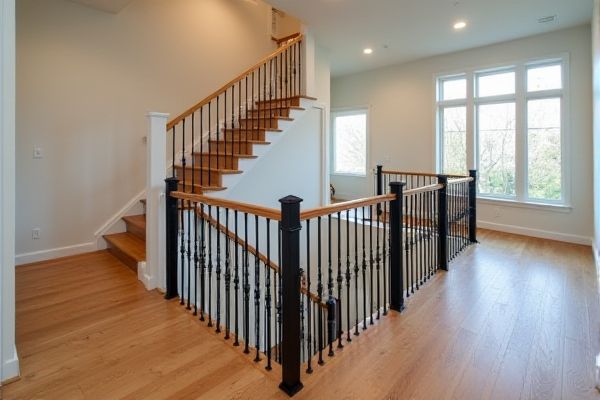
Metal balustrades offer superior durability, modern aesthetics, and low maintenance compared to wood balustrades, which provide a warm, natural look but require regular upkeep and are prone to weathering. Discover the detailed comparison to decide which balustrade best suits Your style and functional needs by reading the full article.
Table of Comparison
| Feature | Metal Balustrade | Wood Balustrade |
|---|---|---|
| Durability | Highly durable, resistant to weather and pests | Moderate durability, prone to rot and termites |
| Maintenance | Low maintenance; occasional cleaning and rust prevention | High maintenance; requires regular sealing and painting |
| Cost | Moderate to high initial cost, cost-effective over time | Generally lower initial cost, higher maintenance cost |
| Appearance | Modern, sleek, customizable designs | Classic, warm, natural aesthetic |
| Weight | Heavier, requires strong support | Lighter, easier to install |
| Environmental Impact | Recyclable materials, energy-intensive production | Renewable resource, biodegradable |
| Safety | Strong and sturdy; good load-bearing capacity | Safe but can weaken over time if not maintained |
Introduction to Metal and Wood Balustrades
Metal balustrades offer superior durability and require less maintenance compared to wood balustrades, making them ideal for outdoor use and high-traffic areas. Wood balustrades provide a warm, natural aesthetic with customizable designs but may demand regular upkeep to prevent weather damage. Your choice between metal and wood balustrades should consider factors such as environmental exposure, desired style, and long-term maintenance commitments.
Material Composition and Aesthetic Appeal
Metal balustrades, composed primarily of aluminum, steel, or wrought iron, offer superior durability, resistance to weather, and a sleek, modern aesthetic suitable for contemporary designs. Wood balustrades, crafted from hardwoods like oak or teak, provide a warm, natural appearance with customizable grain patterns, enhancing traditional or rustic interiors but requiring regular maintenance to prevent decay. Choosing between metal and wood balustrades depends on the desired balance of longevity, maintenance, and visual style preferences for both indoor and outdoor architectural applications.
Durability and Lifespan Comparison
Metal balustrades offer superior durability and a longer lifespan compared to wood balustrades, as they resist weathering, rot, and insect damage more effectively. Your investment in metal ensures minimal maintenance and retains structural integrity for decades, whereas wood balustrades may require frequent repairs and refinishing to prevent deterioration. Choosing metal enhances the longevity of your railing system, especially in harsh outdoor environments.
Maintenance Requirements
Metal balustrades typically require less maintenance than wood balustrades, needing only periodic cleaning and rust prevention treatments such as painting or powder coating to protect against corrosion. Wood balustrades demand regular maintenance including sanding, staining, sealing, or painting to prevent rot, insect damage, and weathering, especially in outdoor environments. The durability of metal balustrades reduces long-term upkeep costs, making them more suitable for low-maintenance design preferences.
Safety and Structural Integrity
Metal balustrades offer superior safety and structural integrity due to their high tensile strength and resistance to environmental factors like moisture and pests, ensuring long-lasting durability. Wood balustrades, while aesthetically pleasing, require regular maintenance to prevent rot, warping, and weakening, which can compromise safety over time. Steel and aluminum metal balustrades meet stringent building codes for load-bearing capacity, making them the preferred choice in high-traffic or commercial applications.
Cost and Budget Considerations
Metal balustrades generally present a higher upfront cost compared to wood balustrades due to the price of raw materials and manufacturing processes. Wood balustrades can be more budget-friendly initially but may require increased long-term maintenance expenses, such as staining and repair. Your choice should balance initial investment with potential upkeep costs to suit your overall budget effectively.
Installation Process Differences
Metal balustrades typically require welding, drilling, and anchoring to concrete or metal frames, demanding specialized tools and skilled labor; their installation is often more time-intensive but results in greater durability and strength. Wood balustrades involve cutting, sanding, and fastening with screws or nails into wooden frameworks, allowing for simpler and quicker installation with basic carpentry skills but may require more maintenance over time. The choice between metal and wood balustrade installation hinges on structural requirements, desired aesthetics, and budget constraints.
Environmental Impact and Sustainability
Metal balustrades often have a lower environmental impact due to their durability and recyclability, reducing the need for frequent replacements. Wood balustrades rely on renewable resources but can contribute to deforestation if not sourced sustainably and may require chemical treatments that affect ecosystems. Choosing metal balustrades can enhance your project's sustainability by minimizing waste and supporting long-term resource efficiency.
Customization and Design Flexibility
Metal balustrades offer superior customization and design flexibility with options like intricate patterns, sleek modern lines, and powder-coated finishes that can match any architectural style. Wood balustrades provide natural warmth and can be carved or stained to suit traditional or rustic designs but are limited in shape and durability compared to metal. Your choice depends on whether you prioritize the versatility and longevity of metal or the classic, organic appeal of wood.
Choosing the Right Balustrade for Your Space
Metal balustrades offer superior durability, low maintenance, and a modern aesthetic ideal for outdoor and high-traffic areas, while wood balustrades provide warmth, natural beauty, and versatility suitable for traditional or rustic interior designs. Consider factors such as environmental exposure, design style, maintenance requirements, and budget when selecting between metal and wood balustrades. Opting for powder-coated steel or aluminum enhances corrosion resistance in metal balustrades, whereas treated hardwoods like teak or oak improve longevity and weather resistance in wooden options.
 homyna.com
homyna.com